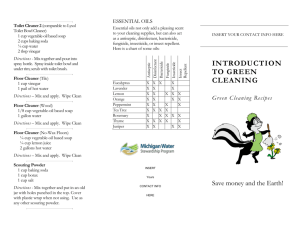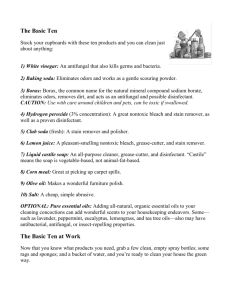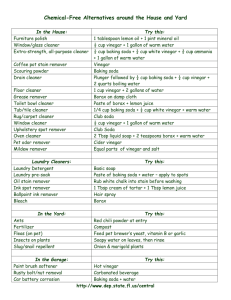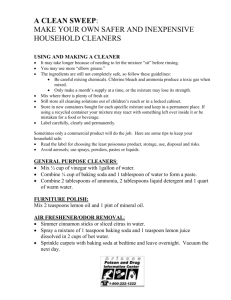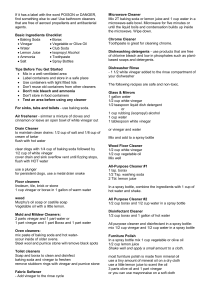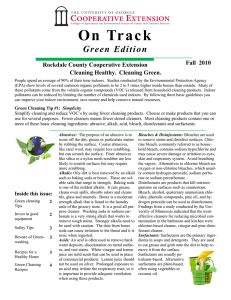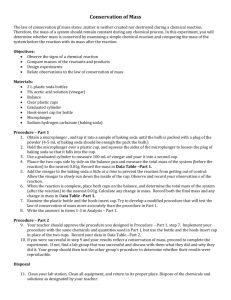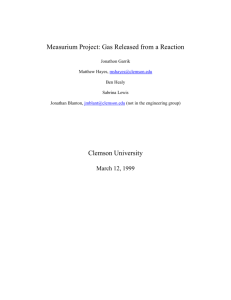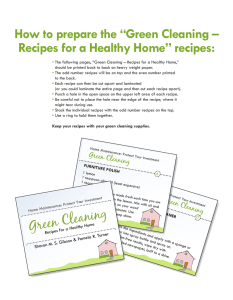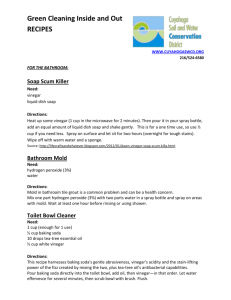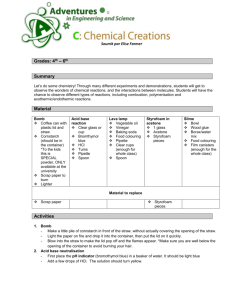Cleaning to Protect Your Health
advertisement
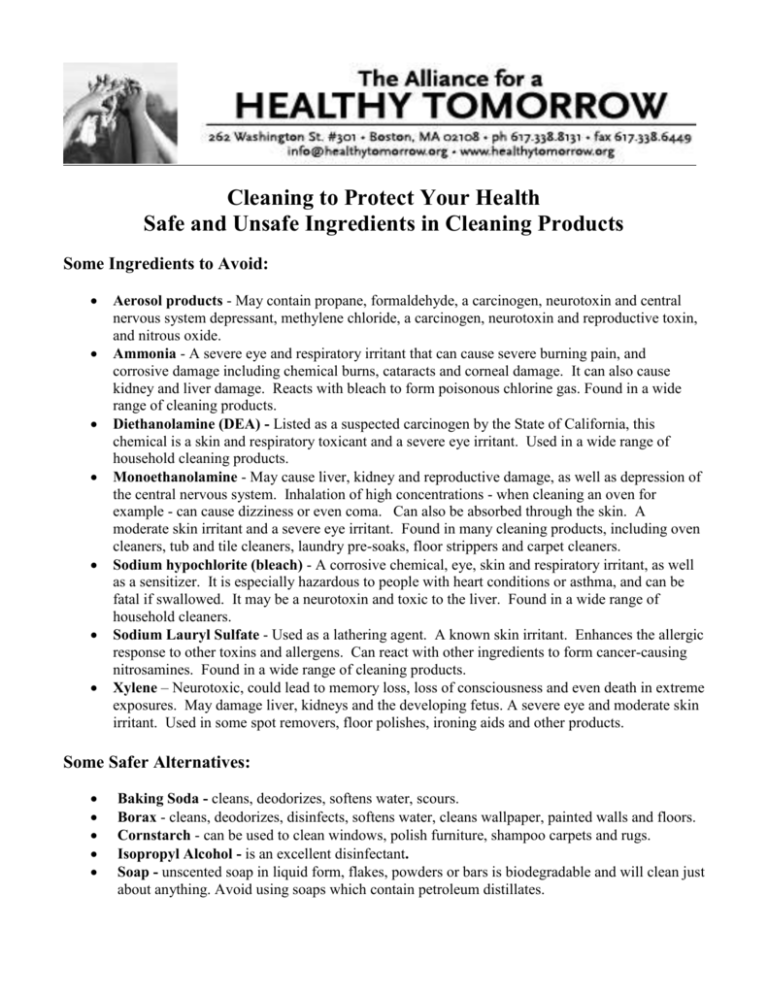
Cleaning to Protect Your Health Safe and Unsafe Ingredients in Cleaning Products Some Ingredients to Avoid: Aerosol products - May contain propane, formaldehyde, a carcinogen, neurotoxin and central nervous system depressant, methylene chloride, a carcinogen, neurotoxin and reproductive toxin, and nitrous oxide. Ammonia - A severe eye and respiratory irritant that can cause severe burning pain, and corrosive damage including chemical burns, cataracts and corneal damage. It can also cause kidney and liver damage. Reacts with bleach to form poisonous chlorine gas. Found in a wide range of cleaning products. Diethanolamine (DEA) - Listed as a suspected carcinogen by the State of California, this chemical is a skin and respiratory toxicant and a severe eye irritant. Used in a wide range of household cleaning products. Monoethanolamine - May cause liver, kidney and reproductive damage, as well as depression of the central nervous system. Inhalation of high concentrations - when cleaning an oven for example - can cause dizziness or even coma. Can also be absorbed through the skin. A moderate skin irritant and a severe eye irritant. Found in many cleaning products, including oven cleaners, tub and tile cleaners, laundry pre-soaks, floor strippers and carpet cleaners. Sodium hypochlorite (bleach) - A corrosive chemical, eye, skin and respiratory irritant, as well as a sensitizer. It is especially hazardous to people with heart conditions or asthma, and can be fatal if swallowed. It may be a neurotoxin and toxic to the liver. Found in a wide range of household cleaners. Sodium Lauryl Sulfate - Used as a lathering agent. A known skin irritant. Enhances the allergic response to other toxins and allergens. Can react with other ingredients to form cancer-causing nitrosamines. Found in a wide range of cleaning products. Xylene – Neurotoxic, could lead to memory loss, loss of consciousness and even death in extreme exposures. May damage liver, kidneys and the developing fetus. A severe eye and moderate skin irritant. Used in some spot removers, floor polishes, ironing aids and other products. Some Safer Alternatives: Baking Soda - cleans, deodorizes, softens water, scours. Borax - cleans, deodorizes, disinfects, softens water, cleans wallpaper, painted walls and floors. Cornstarch - can be used to clean windows, polish furniture, shampoo carpets and rugs. Isopropyl Alcohol - is an excellent disinfectant. Soap - unscented soap in liquid form, flakes, powders or bars is biodegradable and will clean just about anything. Avoid using soaps which contain petroleum distillates. Washing Soda - cuts grease, removes stains, softens water, cleans wall, tiles, sinks and tubs. Use with care; do not use on aluminum. White Vinegar - cuts grease, removes mildew, odors, some stains and wax build-up. Some recipes for homemade nontoxic cleaning products: Freshen air by opening windows for a short period; distribute half-filled dishes of vinegar around the house; boil cinnamon and cloves in a pan of water to scent the air; sprinkle 1/2 cup borax in the bottom of garbage pails or diaper pails to inhibit mold and bacteria growth that can cause odors. All-Purpose Cleaner: Mix 1/2 cup vinegar and 1/4 cup baking soda (or 2 teaspoons borax) into 1/2 gallon (2 liters) water. Store and keep. Use for removal of water deposit stains on shower stall panels, bathroom chrome fixtures, windows, bathroom mirrors, etc. Disinfectant. Mix 1/2 cup borax into 1 gallon of hot water to disinfect and deodorize. Drain cleaner. To open clogs, try a plunger first. If that doesn’t work, pour 1/2 cup baking soda down drain, add 1/2 cup white vinegar, and cover the drain. After 15 minutes, pour hot water to clear residue. Do not use this method after trying a commercial drain opener--the vinegar can react with the drain opener to create dangerous fumes. Floor cleaner and polish. Add 1 cup of vinegar to a pail of warm water. For vinyl or linoleum flooring, add a capful of baby oil to the water. For wood floors add 1/4 cup liquid castile soap and 1 cup vinegar to 8 liters warm water. For brick and stone tiles, use 1 cup white vinegar in 1gallon water and rinse with clear water. Oven cleaner. In a spray bottle, mix 2 tablespoons liquid castile soap, 2 teaspoons borax and warm water to fill bottle. Dissolve completely. Spray on, keeping nozzle close to oven surface. Leave solution on for 20 minutes, and then scrub with nylon scrub pad and baking soda. Scouring powder. Combine 1 cup baking soda, 1 cup borax and 1 cup regular salt. Toilet bowl cleaner. To remove mineral buildup, put 1-2 denture cleaner tablets in bowl and let sit overnight, then clean with white vinegar. Or pour a mixture of 1 cup of borax and 1/4 cup vinegar into toilet and let sit overnight before scrubbing. Tub and tile cleaner. Mix 1/4 cup baking soda with 1/2 cup white vinegar. Window and glass cleaner. To avoid streaks, don't wash windows when the sun is shining. Create a half-and-half mixture of water and vinegar or lemon juice in a non-aerosol spray bottle. Wipe with newspaper. Laundry Products. Soap, rather than detergent, is an effective cleaner for natural fabrics, leaving items softer than detergent. A cup of vinegar added to the wash can help keep colors bright. One-half to threequarters of a cup of baking soda will leave clothes soft and fresh smelling. Silks and wools may be hand washed with mild soap or a protein shampoo, down or feathers with mild soap or baking soda. DO NOT USE CHLORINE BLEACH.
